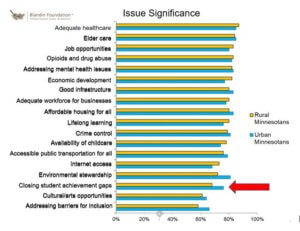 Image: Blog hero Plant Plate 09 boys dig in
Image: Blog hero Plant Plate 09 boys dig in
Rural Pulse 2019: Student success looks different to rural, urban communities

by Jennifer Bevis Posted in Tools You Can Use
Across Minnesota, the Minnesota Comprehensive Assessments (MCA) tests are one measure of how students and schools are performing. But what’s happening beyond school walls? How are communities doing to help students succeed?
It depends on where you live.
Rural Pulse 2019 results show a contrast between how rural and urban residents believe their communities are doing to help kids succeed.

It’s a strong sentiment in every corner of rural Minnesota, too.

So what might rural Minnesota communities be getting right?
Smaller scope = strong relationships
The scope and scale of rural life lends itself to building long-term, strong relationships. Smaller schools, with smaller class sizes, makes building relationships with students easier. This is crucial to students’ success in academics and in life. Research from the Search Institute outlines how relationships with parents, mentors, friends, teachers and program leaders strengthen young people’s ability to relate well to others, regulate their emotions, succeed in school and bounce back from setbacks. Strong relationships with parents can make young people from “high-stressed families” up to
- 21 times more likely to manage their emotions well,
- 17 times more likely to take responsibility for their actions, and
- 5 times more likely to be good at making and keeping plans.
The 2018 SPARK Youth Voice Survey on student/teacher relationships echoes these themes for young people in north-central Minnesota. Those with strong connections are 3.3 times more likely to believe they belong in the school, and 2.3 times more likely to enjoy learning. Young people see various aspects to these relationships.

The Itasca area – like many across rural Minnesota — boasts great examples of after-school programs that support student success, as well. Boys and Girls Club of the Leech Lake Area, and Grand Rapids and Greenway, Rapids Rising and The Movement, as well as 4-H and Community Education provide activities that intentionally build kids’ life skills and important relationships, and notice and support the good choices young people are making.
Community lifeblood
Schools are also a place of key community connection. Like the library or grocery store, it’s where residents from all walks of life gather for activities and events that build the collective psyche of the community. Sports teams and other groups kindle community spirit. (Just ask the community of Coleraine, whose Greenway Raiders were the darling of the 2019 Minnesota State High School hockey tournament, despite having a student enrollment more than 300 less than the next-largest school in their class.)
Valuing this key connector can propel action in rural communities. Hill City, a community of 591, passed a $4 million building referendum in 2017, one of only a handful of districts that have in recent years. It had a 67 percent pass rate.
Urban and achievement gap
For urban residents, there may be a connection between their rating on student success, and their perception of achievement gaps. Some 76 percent of urban respondents said closing the achievement gap is an important community issue, compared to 68 percent of rural residents. It may be that media coverage of test score variations and other factors piques awareness of the among urban residents, leaving them feeling less confident that their communities are supporting students’ success. Rural schools, of course, also see and are addressing achievement gaps.

Putting Rural Pulse Data to Work in Your Community
So what can community members – rural or urban – do to build on our success in student success?
- Discover and use developmental assets: Check out Search Institute’s Developmental Assets and apply them in your community roles that touch young people’s lives. These include actions you can take individually, as well as a series of 7 great questions your organization can ask, like: How might your budget more explicitly reflect your commitment to reinforcing strong relationships with young people?
- See and share ways students are doing good things. The Montana Institute’s Positive Community Norms has more information about that. Their report, Essentials for Childhood: steps to create safe, stable, nurturing relationships and environments, offers goals for communities committed to building places and spaces that support kids.
Communities rural and urban know: the future is hopeful when our young people are well poised to grow into their full potential. That’s what makes communities vibrant and resilient.
Sign Up for E-News
Subscribe to our periodic newsletter for updates and opportunities about vibrant rural Minnesota.